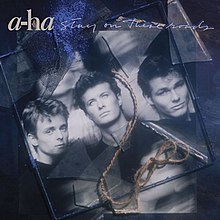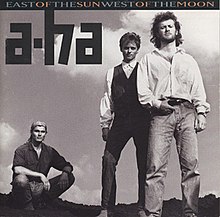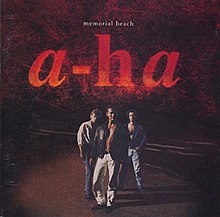
Who remembers a-ha? If you do, you're likely (unless, like me, you're a fan) to shout out “Take on me” or “The sun always shines on TV”! Those with a little more interest may say “Cry wolf” or “Manhattan skyline”, but after that most non-fans will be hard-pressed to list another song from this band, which is sad, as they are now disbanded but over the course of their almost thirty-year career put out nine great albums, and had a string of singles, most of which, not surprisingly, went to the top or did very well in their native Norway. One or two hit wonders? Think again.
 Part I: The sun always shines when you're taking on the world
Part I: The sun always shines when you're taking on the world
Formed in Oslo in 1982, a-ha (their name is spelled with a lowercase “a”) have never changed the lineup that they began with, a trio comprising Morton Harket on vocals, Magne (Mags) Furuholmen on keyboards and Paul Waaktaar-Savoy (who went by the shortened name Pal Wakktaar) on guitar. They were first discovered by producer John Ratcliff when the guys relocated from Oslo to London in search of a career in music. Their first single, the by-now-famous (
too famous?) “Take on me” was their first hit, but not the first time out. In fact, the song had to be released three times before it attained the success and exposure it deserved, and helped elevate the three young lads from Norway to superstar status. It was seen to be the groundbreaking video that accompanied the third release of “Take on me” that got them noticed, and the song raced to number two. Although not their most successful single, it is still remembered as their best, and in some cases only one.

The album that followed the single, their debut, 1985's “Hunting high and low”, was also a huge smash, earning triple platinum status and yielding five singles, four of which charted, three of which were big hits. As a debut it really couldn't be much better. Kicking off with the huge hit single that made their name, it powers on into the third single, the China Crisis-sounding keyboard-driven “Train of thought” and then into the title track, a slow, ethereal ballad with nice masking tracks of seagulls and waves, some really effective crying guitar and Harket's soulful vocal all making this a shoe-in for a single release, which it was.
But it's not just the singles that make this album, though later we hit their second single, and their biggest hit, the bombastic “The sun always shines on TV”. I'm sure you know it, considering how big it was, but it's a great song, starting off with deep keyboards, which then get more strident and insistent until the drums kick in and the guitar gets going, and it's about as close to a rock song as any pop band I know have got. Great stuff, and I had it flagged for a number one the moment I heard it. However, it's songs like the Human League-like “Living a boy's adventure tale” and the wonderfully europop “Dream myself alive” that really lift this album out of the realms of just a collection of hit singles, while the dramatic, powerful closer “Here I stand and face the rain” gives just a hint of the quality songwriting a-ha would engage in over the next thirty-odd years, marking them as much more than just a fly-by-night pop sensation. “Hunting high and low” showed, in no uncertain terms, that a-ha were here for the long haul, not just the quick money.

They followed up the powerful debut one year later with “Scoundrel days”, which even today ranks as one of their best albums. There are about two weak tracks on it, but the rest of the material is so top-notch that you can almost overlook those. The album also yielded them further singles, in the songs “Cry wolf”, “Manhattan skyline” and “I've been losing you”, but as with their debut, it's the songs that
weren't released as singles that stand out the most. From the opening keyboard arpeggios of the title track, the almost whispered vocal to the sudden breakout of drums and solid keys, it's obvious that the debut was not just a flash-in-the-pan, and a-ha are back, in a big way! “Scoundrel days” is a fast bopper with a very urgent sound, almost desperate, and it's a great opener, things not let down at all by “The swing of things”, another fast track with a great middle eighth where everyone pauses for breath before attacking the song for its powerful conclusion.
Whereas Morton Harket had some songwriting input into “Hunting high and low”, on this album he concentrates on doing what he does best, and leaves the writing to the other two bandmembers, Pal Waaktaar in particular, who solo pens four of the tracks. It's an album full of gems, and not just the singles, though they are excellent. Some stirring ballads like the moody, almost not-there “October”, which takes understatement to new levels, Harket's voice almost a whisper throughout and yet very effective, as he allows the combined sound effects of wind and tolling bells do the singing for him. Indeed, the opening of the song has virtually no music until about fifty seconds in, sound effects carrying the mood perfectly.
“Scoundrel days” is the perfect follow-up to an excellent and successful debut, and neatly avoids falling into the trap of “second album syndrome”. A-ha don't seem to be all that bothered about writing a successor to “Take on me” or “The sun always shines on TV”, instead concentrating on just writing excellent songs, almost any of which could have been chosen for the radio or charts, and allowing natural selection to do its work. The only weak tracks I find on this album are the Mags Furuholmen solo effort “Maybe maybe”, with its frankly silly and annoying lyric (
Maybe it was over when you/ Chucked me out the Rover/ At full speed”) and its pseudo-reggae melody, and “We're looking for the whales” (on which both have to accept responsibility as writers), but as I say, the quality of the remainder is so high you can ignore these little bumps on the road.

1988 saw what would be seen as the last “big” a-ha album, “Stay on these roads”. While a great album, there is a small fall in quality from the first two: perhaps we had just been spoiled by the previous offerings! Again, very few weak tracks and some great ones, including the title track, more hit singles in “Touchy”, “The blood that moves the body” and my favourite, the totally-feelgood “You are the one”. Balanced against these are more sombre, downbeat songs like “This alone is love”, “There's never a forever thing” and the immense closer, “You'll end up crying”, which is almost carried completely on strings and close to acapella vocal, if that makes any sort of sense. You have to hear it.
The album also features their longest song to date, almost seven minutes of “Out of blue comes green”, as well as the theme to the James Bond movie, “The living daylights”, written in conjunction with film composer the late John Barry. This helped bring the music of a-ha to a new audience --- filmgoers and in particular Bond fans --- and took the single to number five. Harket helps out on the title track, otherwise, apart from Barry's collaboration, the album is entirely composed by Pal Waaktaar with some help from Mags, but it's mostly his songs on the album, as he emerges as the main songwriting force behind a-ha.

And that was more or less it for “the golden age” of a-ha. After three albums and some very successful hit singles, their fourth album, released in 1990, largely passed the charts and the general record-buying public by. “East of the sun, west of the moon” is not a bad album, but it probably suffers commercially from the decision by the band to eschew the pop charts song prevalent on the last three albums and opt for a darker, more mature tone that almost moves entirely away from pop and more into the spectrum of rock. Apart from the cover of the Everly Brothers' “Crying in the rain” (on which they do a passable job), which opens the album, there are no obvious singles, no dancy numbers, no simple songs. Pal, who by now was married to Lauren and adopted her surname Savoy into his, becoming Pal Waaktaar-Savoy, shares most of the writing duties with Mags, and the result is a somewhat confused collection of songs, some good, some bad, none terribly great. On this album, it was clear that the heady days of “Take on me” and “Manhattan skyline” were long gone.
The only track that comes close to the pop sensibilities of their previous output really is the second one, “Early morning”, but even that is infused with melancholia and darkness, Morton singing now more as a serious vocalist than just the frontman of a pretty-boy pop trio, which was essentially how he had been seen up to now; many teenage girls (my own sister included) had his poster on the wall and swooned over him at night. The new, darker, grittier approach of “East of the sun” did not appeal to those sort of fans, and consequently it seemed they deserted a-ha in droves, the album selling well but nowhere near as well as previous ones.
What “East of the sun” did demonstrate amply however was the brilliant musicianship of the band, talents which, although certainly evident on the last three albums, had been somewhat overshadowed by the success of pop singles and their own cult of personality among the fickler of their fans. It was obvious that Mags was a great keyboard player and a fine pianist, while Pal's expertise on the guitar, never challenged, began to shine through on songs like “Sycamore leaves” and “Cold river” . At this point, a-ha began to become very popular in places like Brazil and indeed they headlined the Rock in Rio II festival in 1991, but even though they drew the largest crowd (breaking records and beating out big hitters like Prince, George Michael and even Guns 'n' Roses) they were largely ignored by the music press, the curse of “Take on me” and their perception by the media as a pop and not a rock band dealing them a devastating blow, from which they would really never recover.
A-ha had always written obscure lyrics, mostly shying from the standard fare of pop singles --- even big hits like “Cry wolf”, “Train of thought” and “Manhattan skyline” have odd lyrics that aren't immediately obvious --- and this practice evolved even more as their albums became more mature and less polished pop. Tracks like “Slender frame”, “Sycamore leaves” and the excellent but simple “(Seemingly) Nonstop July” are examples of the thought and care a-ha would put into their writing: mostly, it has to be accepted, Pal Waaktaar-Savoy, who wrote the lion's share of their material. Lyrics like
”Can't stop thinking 'bout it/ It fills me with unease /Out there by the roadside something's buried/ Under sycamore leaves” and
”So many lifetimes /You've been waiting for it / All through the good times/ When you tried to ignore it / You hesitate/ It's come too late /You hear the sound /Of when wheels engage” just didn't sit well with fans more used to the often bland pop lyrics of certainly the first two albums, and the new, darker sound did not attract them.

So the stage was set for the partial decline of a-ha, or to be more accurate, their abandonment by their pop fans in favour of more hardcore, serious listeners who would take the band on the merits of their songs and their albums, not just their hit singles. “Memorial Beach”, released 1993, sold even more poorly, leading to the band deciding to break up temporarily while they pursued other projects. Another dark album, “Memorial Beach” has some great tracks on it, including the opener, “Dark is the night for all”, “Angel in the snow”, written by Pal as a gift to his wife on their wedding, and “How sweet it was”. It also features a song which beats out “Stay on these roads”'s seven-minute opus “Out of blue comes green” as the longest a-ha song to date, “Cold as stone”, coming it at almost eight and a half minutes.
With Pal again taking over most of the songwriting duties, “Memorial Beach” continues the more adult, measured approach seen on “East of the sun, west of the moon”, and with the exception of the boppy “Move to Memphis”, there's very little about this album that's not dark and moody. Well, “Angel in the snow” is a gorgeous and touching little ballad, yes, but the whole album other than those two is heavier, crunchier and grittier than any a-ha release to date. Cue more pop fans fleeing in dismay!
In 1994, disappointed with the reception their last album had gained, and interested in trying out solo projects, the band split --- or more correctly, went on hiatus --- until 1998, when they made a comeback at the Nobel Peace Prize Concert in their hometown of Oslo, and soon afterwards they got back together properly, releasing at the turn of the millennium their sixth album, “Minor earth major sky”.